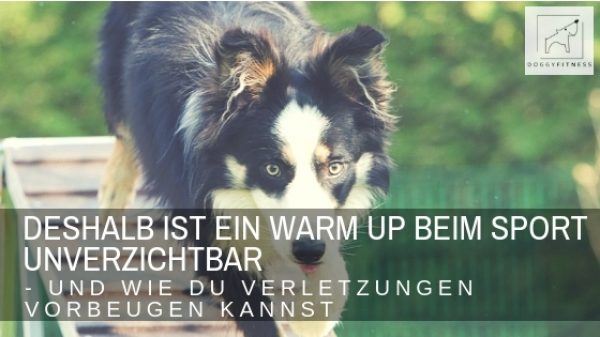Warm up – Active warm up for dogs
The number of dog athletes and sporting dogs is growing and yet Warm Up is not a given. A good warm up program is often the exception.
For us humans, it is natural to clean up before we go jogging or do any other sport. We humans warm up our muscles. We stretch and thus prepare ourselves for the upcoming load. So why don’t we do the same with our dogs?
The counter question many dog owners ask in response is, “Does the wolf warm up before it goes hunting?!” If you observe the wolf, you can see that he stands up, stretches and stretches. Now he starts moving slowly, first at a walk, then at a trot. The tempo slowly increases, the body tension as well. The rabbit usually doesn’t wait right around the corner, so a longer period of trotting, through branches, over logs follows. The wolf makes jumps, he ducks, has to balance. Only then does he sight his prey, sneak up and jump.
Why is an active warm up so important for your dog?
By a specific warming up you prevent consequential damages for your dog. Likewise, you avoid injuries and your dog is more efficient. With proper warm-up, you prepare the dog physically and mentally for performance. He is focused and motivated.
What happens during the warm up?
Body temperature and heart rate increase and blood flow is increased. The muscles, nerves, tendons and ligaments are supplied with more oxygen and nutrients. Because that’s exactly what they need when they have to deliver increased performance. Proper warming up increases the production of the important synovial fluid in the joints. It guarantees smooth functioning of the joints. The joints become more mobile, they become more elastic and resilient. This prevents later damage to the joints. Warming up the back muscles stabilizes, supports and relieves the spine. Muscles, ligaments and tendons become supple and elastic and injuries are prevented.
Nerves also play a major role
The nerve pathways are better supplied, coordination is improved and movement patterns can be recalled better and faster. Perception, attention and performance are increased physically as well as physically. The cardiovascular system is prepared for the coming load; the breathing rate and heartbeat increase. This ensures that the muscles are supplied with sufficient oxygen. Warming up increases the body temperature by 1 to 1.5 °C.
Important:
- Warming up is not a training time, it should not tire the dog, but activate it!
- Proper warm-up means moving from slow to faster and from general to sport-specific exercises.
- There should be no long waiting times (maximum 5 minutes) between warm up and training. Keep your dog warm during a waiting period. In winter, a dog coat makes perfect sense here.
There are some important points to consider:
- The colder the outside temperature, the longer the warm-up period must be.
- The worse the dog is trained, the longer the warm-up period must be.
- The older the dog, the longer the warm-up period must be.
Let’s go! – How does a warm up work?
First of all, there is the mental warm up
We know it from ourselves and it is no different for high-performance athletes. Already with packing the bag, putting on the sports clothes, we mentally prepare ourselves for the sport. We are concentrated, focused and prepare for the sport. Body and mind are in a certain basic tension.
It is no different for our dogs
They immediately sense when it’s time to go to the dog park. A ritual like putting on a special harness or collar, packing up certain utensils makes him pay attention and he knows it’s starting. Arriving at the dog park is usually already associated with whimpering and barking from excitement. Your pelt bunny can’t wait to get started. Before it starts, give your dog a chance to get loose. Eating before the workout is taboo. Because training is not only bad on a full stomach. It’s also hazardous to your health if you think about gastric distention, for example.
The active warm up consists of several stages and should be structured sensibly to be effective.
General exercises and stretching
Always start the active warm up by warming up and loosening up the large muscle groups of the back, front and hind legs. This includes, for example, uniform preparation of the entire body with warm-up running, stretching, step-up runs. Allow about 10 minutes for this.
The specific warm up
Then warm up the specific muscle groups. Align them according to what performance the body should provide and which parts of the body are particularly required. Take about 5 minutes to do this.
What exactly does an optimal warm up look like and which exercises can you use?
In my next blog post, I’ll put together an active warm up for your dog that will best prepare your dog for sports. I’ll explain exactly which exercises you use to warm up which parts of your body and how they work. With this warm up you minimize the risk of injury and later joint damage.
Do you have questions about the post or a topic request? Then feel free to write me a comment or a message!
Dieser Beitrag ist auch verfügbar auf:
Français (French)
Deutsch (German)
Español (Spanish)















